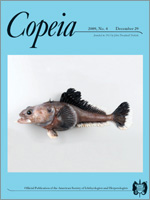Because many species of semi-aquatic turtles have specific habitat requirements and unique life history characteristics, they are particularly vulnerable to anthropogenic habitat modification. The federally threatened Bog Turtle (Glyptemys muhlenbergii) requires specialized wetland habitats, such as bogs and fens, in the eastern United States and often occurs in isolated populations. To develop a more a detailed understanding of the habitat use, movement, and thermal biology of Bog Turtles, we radiotracked and monitored the temperatures of 11 adult Bog Turtles at an isolated Piedmont meadow bog in North Carolina from May 2007 to March 2008. We found that turtles used soft, shallow mud habitat in the bog, but moved to a streambed when the bog became dry. While in the bog, turtles were often found within or underneath woody debris. Although most turtles resided exclusively in the southern part of the bog and the stream, two male turtles made substantial over-land movements away from the bog exceeding 130 m. All but one turtle overwintered in a streambed adjacent to the bog. Turtles overwintering within stream habitat were not exposed to temperatures below 0°C, but one turtle that overwintered in the bog did reach below-freezing temperatures. This study suggests that high-quality bog habitat and habitat heterogeneity are critical for populations living in isolated and dynamic habitats. However, maintenance of corridors between suitable habitats may be necessary for the long-term survival of Bog Turtle populations.
How to translate text using browser tools
29 December 2009
Movements, Habitat Use, and Thermal Ecology of an Isolated Population of Bog Turtles (Glyptemys muhlenbergii)
Shannon E. Pittman,
Michael E. Dorcas
ACCESS THE FULL ARTICLE





